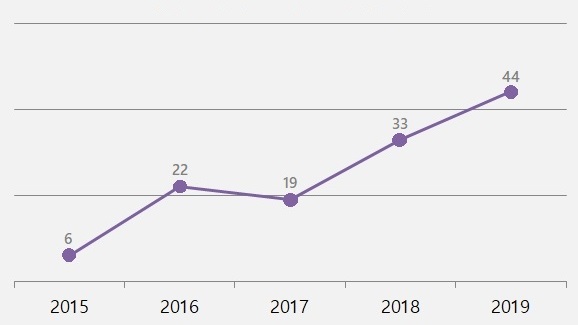IP Report
IP News
Massive Surge in Sound Mark Applications According to Diversification of Marketing Strategies
The Korean Intellectual Property Office (Commissioner: Wonju Park) announced that the applications for registration of sound marks, which are trademarks that protect sounds such as scales and rhythms, and buzzwords used for broadcast advertisements, have increased by about 7.3 times from 6 cases in 2015 to 44 cases in 2019.
< Trends in filing sound marks over the past 5 years>

 This change shows that, along with general word marks or figurative marks having visible effects, the importance of non-visible signs stimulating a consumer's senses, such as senses of hearing and smell, is gradually growing as marketing strategies are performed via various media.
This change shows that, along with general word marks or figurative marks having visible effects, the importance of non-visible signs stimulating a consumer's senses, such as senses of hearing and smell, is gradually growing as marketing strategies are performed via various media.
Currently, there are representative examples of sound marks registered in Korea such as ring tones used for smart phones of Samsung electronics, message alerts of Kakao Corporation, etc. Further, a punchy buzzword by a famous comedian is also registered as a sound mark in the advertising and entertainment service industries.
<Examples of sound marks>
|
Applicant company |
Trademark |
Designated goods |
|
Samsung electronics, Co., Ltd. (40-1183121) |
This sound mark is a musical melody which is about 4 seconds long as shown in the attached file and score, and consists of four notes starting with G in the key of C Major (4/4) and ending on G (one octave). The corresponding melody is played 1) G (quarter note: 1 beat) 2) C (eighth note: 1/2 beat), 3) B (eighth note+eighth note: 1 beat), and 4) G (one octave) (eighth note+quarter note+half note: 3.5 beats).
|
Smart phone <Class 9> * Registered on the basis of distinctiveness through using marks |
|
Kakao Corporation (40-1565827) |
This sound mark includes ‘Ka-tok-wa-ssyong (which means ‘you have a new message’ in Korean),’ which consists of four syllables quickly pronounced in a woman’s voice, as played in the attached sound source. Compared to the first two syllables of ‘Ka-tok,’ the third syllable ‘wa’ has a slightly lower tone, and the fourth syllable ‘ssyong’ is pronounced in a far lower tone than the third one. The first three syllables are quickly pronounced in a staccato-like shortened and separated sound without a break, and the last syllable is slightly longer than the first three. There is a creation of a sound file ‘Katokwassyong.mp3’ which is submitted with the application. |
Software for Smart TV (application), computer software for transmission of sound and video messages, e-commerce software for computer, communication software, digital broadcasting, and multimedia content broadcasting using the Internet <Classes 9 and 38> |
|
Taegyun Kim·Chanwoo Jeong (40-1304459) |
This sound mark includes ‘Ssaeng-ddung-mat-jyo’ in Korean (which means ‘it is awkward’) as played in the attached file, and the first syllable ‘SSaeng’ is emphasized by being pronounced slightly stronger and longer than the other syllables. The two syllables ‘ddung-mat’ are pronounced as a shortened prolonged sound. The last syllable ‘jyo’ is pronounced as a slightly long sound with a higher intonation at the end. Further, there is a creation of a sound file ‘Ssaengddungmatjyo.mp3’ which is submitted with the application. |
Advertising/marketing, PR, copy writing, radio advertisement, live entertaining performances, entertainer performance services, and entertainer services, etc. <Classes 35 and 41> |
Samseop Mun, the director of the trademark and design examination division at the Korean Intellectual Property Office, said that “when companies in Korea build up their solid and unique identities actively using sound marks and scent marks as well as visual trademarks such as words, logos, etc., it will be very helpful to gain competitiveness not only in the domestic market but also in the global market.”
Meanwhile, sound marks can be registered when the sound has been used continuously in advertisements so that the mark is widely known to be recognized as a source of a certain person’s goods by general consumers, or when the mark is expressed in a distinctive sound of a certain term’s pronunciation so that the mark itself is acknowledged to have distinctiveness.
(See the press release from KIPO dated May 4, 2020)




